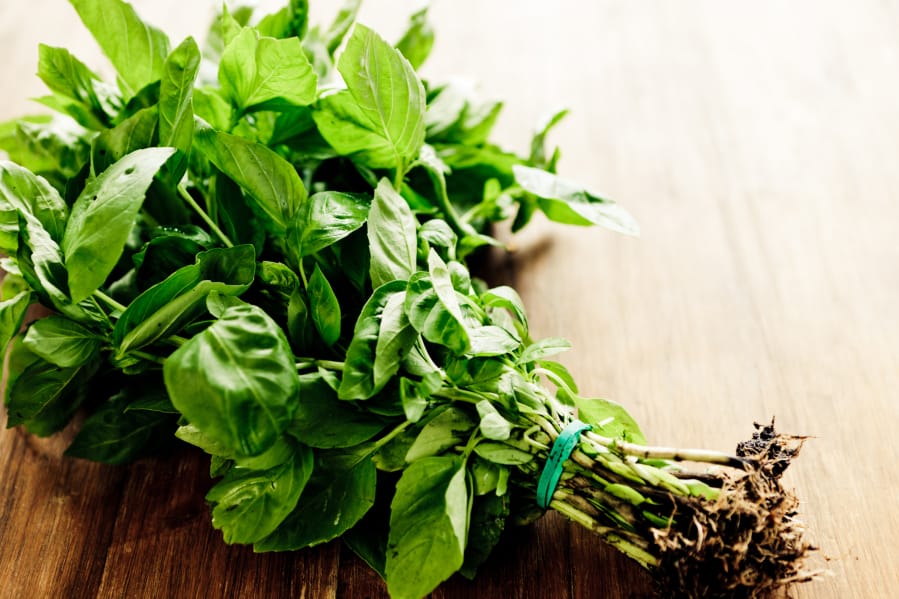Did you know that basil is an herb that belongs to the mint plant family? Basil is a sweet, slightly bitter complement to a variety of dishes around the world. There are up to 150 different varieties of basil, and each has its own distinct aroma and taste. It is grown worldwide and used in many cultural cuisines. In the U.S., we associate the velvety leaves of sweet basil with Italian food, but there are so many varieties (more than we can list!) with flavors that range from sweet to spicy to slightly bitter.
Sweet basil is the most popular basil choice for Italian sauces and soups and for making pesto. Varieties include Genovese, Napoletano, Italian large leaf and lettuce leaf. Harvest the top four leaves often to keep the plant growing and sweetly flavored.
Sweet Thai basil is an Asian variety with a distinct, spicy, anise or clove flavor. It is usually added to stir-frys at the last minute. Its spicy flavor is aggressive when eaten raw but lightens up when cooked. It has purple stems and speckled green leaves.
Spicy bush basil has tiny leaves on a small mounded plant. Just a few of these intensely flavored leaves with ginger undertones add a punch to a sauce or soup. The plants are a soft green and leaves are one-half to 1-inch long.
Equivalents
• One bunch equals 2.5 ounces.
• One bunch of basil contains about 60 sprigs of basil.
• One bunch equals about 1 cup of packed/chopped basil leaves.
• 2 cups of loose basil leaves are in a bunch.
• ¾ of a teaspoon per sprig.
Dark opal basil is similar to sweet basil but has a deep purple color that intensifies when cooked. It adds color and spice to salads or garnish. It makes a nice purple-colored pesto, which adds an unexpected color and flavor to your pasta or bruschetta. A feathery variation of this is Purple Ruffles.
Holy basil or sacred basil is a furry-stemmed plant with strongly scented green or purple leaves that are thin and tender. It is grown for religious and medicinal purposes. Its leaves can be used to make tea for boosting your immune system.
Lemon basil can add a delicate tangy flavor to salad dressings, teas or soups, adding a nice sweet flavor. Its fragrant aroma works well when rubbed onto chicken or fish. A sprig in a glass of iced tea is delightful on a hot summer day. Lemon basil is most often seen in Persian, Indonesian and Thai cuisines.
Lime basil is a compact plant with small green leaves. This basil variety’s lime scent and flavor makes it great in fish and chicken dishes. A simple syrup infused with lime basil is a delicious addition to tea and margaritas.
The best way to store basil is to trim the stems and put in a glass of water and cover the leaves with a plastic bag. Leaves will stay fresh for up to a week. Not enough room in the refrigerator? Then pluck the leaves from the stems and layer in paper towel, roll and place in plastic bag.
For the greenest, freshest-seeming basil, blanch the basil in boiling salt water for 15 seconds, drain, and dunk it into ice water to cool it quickly. This sets the green color. Next puree the leaves in a blender with 1 tablespoon of olive oil per cup of basil. Pour the pur?e in ice cubes trays, freeze them, and transfer the cubes to re-sealable plastic bags where they keep for up to a year.
Basil and other herbs are low-acid foods. Adding them to oil creates an oxygen-free environment that can support the growth of the bacteria that causes deadly botulism. Because there are no home-canning recommendations for pesto, for long-term storage freezing is recommended.
For additional recipes, check out Chef Scotty’s Market Fresh Recipes at http://extension.wsu.edu/clark/?p=8163. The FINI program provides help to SNAP consumers to purchase more fruits and vegetables at local farmers markets. Find out more at www.clark.wa.gov/public-health/snap-farmers-markets.
Sandra Brown, WSU Faculty Emeritus, is a Clark County WSU Extension Master Food Preserver. For additional recipes, food preservation and food safety information visit http://extension.wsu.edu/clark/?p=1134. Have questions? Call MFP Helpline: 360-397-6060 ext. 5366 or join Facebook discussion group “WSU Home Food Preservers – Clark County.”



